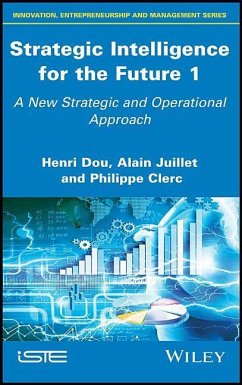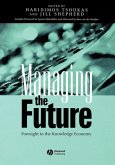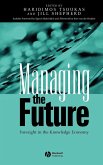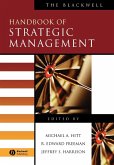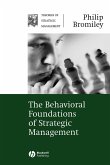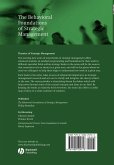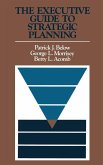Henri Dou, Alain Juillet, Philippe Clerc
Strategic Intelligence for the Future 1
A New Strategic and Operational Approach
Henri Dou, Alain Juillet, Philippe Clerc
Strategic Intelligence for the Future 1
A New Strategic and Operational Approach
- Gebundenes Buch
- Merkliste
- Auf die Merkliste
- Bewerten Bewerten
- Teilen
- Produkt teilen
- Produkterinnerung
- Produkterinnerung
Information in all its forms is at the heart of the economic intelligence process. It is also a powerful vector of innovation and, more than ever, a balance between economic and societal forces. Strategic Intelligence for the Future 1 analyzes the need for the French economic intelligence to mutate in order to develop the economy, strengthen social cohesion and protect vital interests. This mutation requires a change of attitudes and a new way of thinking, widely open to global change and new technologies. The focus of the French economic intelligence on conventional objectives such as…mehr
Andere Kunden interessierten sich auch für
![Strategic Intelligence for the Future 2 Strategic Intelligence for the Future 2]() Henri DouStrategic Intelligence for the Future 2187,99 €
Henri DouStrategic Intelligence for the Future 2187,99 €![Managing the Future Managing the Future]() H. Haridimos Tsoukas / J. Jill ShepherdManaging the Future44,99 €
H. Haridimos Tsoukas / J. Jill ShepherdManaging the Future44,99 €![Managing the Future Managing the Future]() H. Haridimos Tsoukas / J. Jill ShepherdManaging the Future104,99 €
H. Haridimos Tsoukas / J. Jill ShepherdManaging the Future104,99 €![The Blackwell Handbook of Strategic Management The Blackwell Handbook of Strategic Management]() HITT MICHAEL A / FREEMAN RE R. EDWARD / HARRISON S JEFFREYThe Blackwell Handbook of Strategic Management55,99 €
HITT MICHAEL A / FREEMAN RE R. EDWARD / HARRISON S JEFFREYThe Blackwell Handbook of Strategic Management55,99 €![The Behavioral Foundations of Strategic Management The Behavioral Foundations of Strategic Management]() Philip BromileyThe Behavioral Foundations of Strategic Management51,99 €
Philip BromileyThe Behavioral Foundations of Strategic Management51,99 €![The Behavioral Foundations of Strategic Management The Behavioral Foundations of Strategic Management]() Philip BromileyThe Behavioral Foundations of Strategic Management100,99 €
Philip BromileyThe Behavioral Foundations of Strategic Management100,99 €![The Executive Guide to Strategic Planning The Executive Guide to Strategic Planning]() Patrick J BelowThe Executive Guide to Strategic Planning69,99 €
Patrick J BelowThe Executive Guide to Strategic Planning69,99 €-
-
-
Information in all its forms is at the heart of the economic intelligence process. It is also a powerful vector of innovation and, more than ever, a balance between economic and societal forces. Strategic Intelligence for the Future 1 analyzes the need for the French economic intelligence to mutate in order to develop the economy, strengthen social cohesion and protect vital interests. This mutation requires a change of attitudes and a new way of thinking, widely open to global change and new technologies. The focus of the French economic intelligence on conventional objectives such as business and the economy does not allow for the integration of its multiple possible fields and thus its global nature. The strategy, foresight and temporal dynamics necessary to the understanding of the world, and the new balance of power and control of complex situations, have thus increased the time needed to put this in place. Both theoretical and practical, this book provides a basis from which to develop "enhanced economic intelligence" leading to the implementation of global security.
Hinweis: Dieser Artikel kann nur an eine deutsche Lieferadresse ausgeliefert werden.
Hinweis: Dieser Artikel kann nur an eine deutsche Lieferadresse ausgeliefert werden.
Produktdetails
- Produktdetails
- Verlag: Wiley
- Seitenzahl: 256
- Erscheinungstermin: 30. April 2019
- Englisch
- Abmessung: 218mm x 145mm x 28mm
- Gewicht: 658g
- ISBN-13: 9781786302311
- ISBN-10: 1786302314
- Artikelnr.: 55793818
- Herstellerkennzeichnung
- Libri GmbH
- Europaallee 1
- 36244 Bad Hersfeld
- gpsr@libri.de
- Verlag: Wiley
- Seitenzahl: 256
- Erscheinungstermin: 30. April 2019
- Englisch
- Abmessung: 218mm x 145mm x 28mm
- Gewicht: 658g
- ISBN-13: 9781786302311
- ISBN-10: 1786302314
- Artikelnr.: 55793818
- Herstellerkennzeichnung
- Libri GmbH
- Europaallee 1
- 36244 Bad Hersfeld
- gpsr@libri.de
Henri Dou is Chairman of the CIWORLDWIDE think tank and an international consultant. He has developed teaching and research in technology intelligence, competitive intelligence, patent analysis and regional development. Alain Juillet is President of the Académie de l'Intelligence Economique and an international consultant. His expertise is recognized in geopolitics, crisis management, influence, intelligence and security at an international level. Philippe Clerc is President of the Association Internationale Francophone d'Intelligence Economique and an expert advisor in international economic intelligence at CCI France.
Preface xi
Introduction xiii
Chapter 1 For a New Strategic and Competitive Intelligence 1
1.1 Our assessment 1
1.2 The present day 4
1.3 Tomorrow 7
1.4 Conclusion 10
1.5 References 10
Chapter 2 Geopolitics and Strategic Intelligence 15
2.1 Principles of analysis 15
2.1.1 Getting to the point 15
2.1.2 Having an open mind 17
2.1.3 Knowing how to decode information 18
2.1.4 Learning how to sort through information 19
2.2 The evolving world 20
2.2.1 The increasing power of the individual 21
2.2.2 The evolution of power relationships 22
2.3 A changing world 29
2.3.1 International institutions 29
2.3.2 Bilateral agreements 30
2.4 Increased risks 30
2.4.1 Climate risks 30
2.4.2 Risks linked to resources 31
2.4.3 Medical risks 31
2.4.4 Natural risks 32
2.4.5 Political risks 32
2.4.6 Nuclear risks 33
2.4.7 Cyber risks 33
2.5 Conclusion 34
2.6 References 34
Chapter 3 Competitive Intelligence Schools Across the World: Foundations,
Influence and Perspectives 39
3.1 Introduction: what is the competitive intelligence school? 39
3.2 Visions that inspire schools of thought 42
3.2.1 "Power countries" 43
3.2.2 "Emerging countries" 45
3.3 The advent of the competitive intelligence schools 49
3.3.1 Geopolitical and geoeconomic framework 49
3.3.2 Doctrines 51
3.4 The "nourishing disciplines" of competitive intelligence and
communities of public/private practice 63
3.4.1 Disciplines and "schools of practice" 64
3.4.2 The African and Chinese schools of competitive intelligence 66
3.5 Conclusion 77
3.6 References 78
Chapter 4 Competitive Intelligence as a Vehicle for International
Collaboration 85
4.1 The arrival of new signs 85
4.1.1 Definitions of competitive intelligence 85
4.1.2 Maintaining competitive advantages 86
4.2 Increasing instability 87
4.2.1 More developed countries 87
4.2.2 Low-income countries 87
4.3 The French example 88
4.4 Collaboration 89
4.4.1 The foundations of collaboration 89
4.4.2 Academic collaboration 90
4.4.3 Bilateral network collaborations 91
4.4.4 Collaboration between organizations 96
4.4.5 Collaborations through international institutions 98
4.4.6 Collaboration via chambers of commerce and industry 100
4.5 Conclusion 101
4.6 References 101
Chapter 5 Regional Competitive Intelligence 105
5.1 What do we mean by territories? 106
5.1.1 Regional and international patterns of economic development and
innovation 107
5.1.2 Intelligent specialization strategies 108
5.2 A typology of territories 109
5.3 Definition of territorial intelligence 110
5.4 The challenges of territorial intelligence 112
5.5 Rethinking our intelligence capabilities in territorial situations 115
5.5.1 Strategic coordination deficits 115
5.5.2 Needing to be organized 115
5.6 The intelligence of situations 117
5.6.1 The establishment of competitive and strategic regional facilities
118
5.6.2 The goals of these facilities 118
5.7 The main areas of intervention of this competitive intelligence and
regional strategic facility or organization 119
5.8 The generic configuration of the facility 120
5.8.1 Regional strategic steering group (CRPS) 120
5.8.2 The interpretational group 120
5.8.3 The spotters 120
5.9 Strategic management approach: mapping and analysis tools 121
5.9.1 The map of key territory actors 121
5.9.2 Critical resources of a territory 122
5.9.3 The influence potential of a territory 122
5.10 Operational implementation 123
5.11 Conclusion 124
5.12 References 124
Chapter 6 Influence 127
6.1 The current foundations of influence 127
6.2 Who is going to communicate? 129
6.3 Knowledge of the target and information 130
6.4 Rumors 131
6.5 The "media sounding board" 132
6.6 Cultural or public diplomacy 135
6.7 Positive influence 136
6.7.1 Influence, rumors and territorial attractiveness 136
6.7.2 Becoming attractive 137
6.8 Conclusion 138
6.9 References 139
Chapter 7 Sphere of Influence 145
7.1 The return of geopolitics in the economic field 146
7.2 Power strategy and influence strategy 147
7.2.1 States 148
7.2.2 Companies 149
7.3 The sphere of influence: illustrations 151
7.3.1 Definitions 151
7.3.2 The sphere of influence of a company 154
7.3.3 The sphere of influence of a territory 156
7.4 Conclusion 159
7.5 Bibliography 160
Chapter 8 Organizational Intelligence 163
8.1 Definition 164
8.2 Organizational intelligence and cognitive pathologies 165
8.2.1 The brakes of the organization 165
8.2.2 Corporate culture: both a brake and lever of organizational
intelligence 165
8.3 An example: the US-Japan FSX Fighter program or "thinking out of the
silos" 168
8.4 Organizational intelligence and strategies 170
8.4.1 Networks 171
8.4.2 Agile organizations 172
8.4.3 A network of experts 173
8.4.4 The culture of organizations: management of cognitive biases and
vehicle for the creation of a knowledge base of the environment 174
8.4.5 Managing the culture of organizations 175
8.4.6 Learning organization 176
8.5 Collective intelligence and organization of sensor networks 176
8.6 Conclusion 178
8.7 References 179
Chapter 9 From Military Intelligence to Competitive Intelligence 181
9.1 From the military to the economy 181
9.1.1 Military warfare 181
9.1.2 Integration of the economy 182
9.1.3 The priority of the economy 183
9.1.4 The economic army 183
9.2 Forms and aims of intelligence 184
9.2.1 The importance of intelligence 184
9.2.2 Economic intelligence 185
9.2.3 Global intelligence 186
9.2.4 Intelligence as global tool 186
9.3 The practice of intelligence 188
9.3.1 Intelligence for everyone 188
9.3.2 Weak and strong signals 189
9.3.3 The tools of intelligence 190
9.3.4 Sources of intelligence 191
9.3.5 Public/private collaboration in company intelligence 192
9.4 Intelligence and its cycle 193
9.4.1 Decoding what we might notice to understand reality 193
9.4.2 The intelligence cycle 196
9.4.3 Knowing oneself 197
9.4.4 Definition of the research framework 197
9.4.5 Prospective vision 197
9.4.6 The research plan 198
9.4.7 Collecting data 199
9.4.8 Data cross-checking 200
9.5 Analysis 200
9.6 The synthesis of information and its dissemination 201
9.6.1 From adequacy to expectations 202
9.7 Conclusion 202
9.8 References 204
Conclusion 207
Index 213
Summary of Contents of Volume 2 217
Introduction xiii
Chapter 1 For a New Strategic and Competitive Intelligence 1
1.1 Our assessment 1
1.2 The present day 4
1.3 Tomorrow 7
1.4 Conclusion 10
1.5 References 10
Chapter 2 Geopolitics and Strategic Intelligence 15
2.1 Principles of analysis 15
2.1.1 Getting to the point 15
2.1.2 Having an open mind 17
2.1.3 Knowing how to decode information 18
2.1.4 Learning how to sort through information 19
2.2 The evolving world 20
2.2.1 The increasing power of the individual 21
2.2.2 The evolution of power relationships 22
2.3 A changing world 29
2.3.1 International institutions 29
2.3.2 Bilateral agreements 30
2.4 Increased risks 30
2.4.1 Climate risks 30
2.4.2 Risks linked to resources 31
2.4.3 Medical risks 31
2.4.4 Natural risks 32
2.4.5 Political risks 32
2.4.6 Nuclear risks 33
2.4.7 Cyber risks 33
2.5 Conclusion 34
2.6 References 34
Chapter 3 Competitive Intelligence Schools Across the World: Foundations,
Influence and Perspectives 39
3.1 Introduction: what is the competitive intelligence school? 39
3.2 Visions that inspire schools of thought 42
3.2.1 "Power countries" 43
3.2.2 "Emerging countries" 45
3.3 The advent of the competitive intelligence schools 49
3.3.1 Geopolitical and geoeconomic framework 49
3.3.2 Doctrines 51
3.4 The "nourishing disciplines" of competitive intelligence and
communities of public/private practice 63
3.4.1 Disciplines and "schools of practice" 64
3.4.2 The African and Chinese schools of competitive intelligence 66
3.5 Conclusion 77
3.6 References 78
Chapter 4 Competitive Intelligence as a Vehicle for International
Collaboration 85
4.1 The arrival of new signs 85
4.1.1 Definitions of competitive intelligence 85
4.1.2 Maintaining competitive advantages 86
4.2 Increasing instability 87
4.2.1 More developed countries 87
4.2.2 Low-income countries 87
4.3 The French example 88
4.4 Collaboration 89
4.4.1 The foundations of collaboration 89
4.4.2 Academic collaboration 90
4.4.3 Bilateral network collaborations 91
4.4.4 Collaboration between organizations 96
4.4.5 Collaborations through international institutions 98
4.4.6 Collaboration via chambers of commerce and industry 100
4.5 Conclusion 101
4.6 References 101
Chapter 5 Regional Competitive Intelligence 105
5.1 What do we mean by territories? 106
5.1.1 Regional and international patterns of economic development and
innovation 107
5.1.2 Intelligent specialization strategies 108
5.2 A typology of territories 109
5.3 Definition of territorial intelligence 110
5.4 The challenges of territorial intelligence 112
5.5 Rethinking our intelligence capabilities in territorial situations 115
5.5.1 Strategic coordination deficits 115
5.5.2 Needing to be organized 115
5.6 The intelligence of situations 117
5.6.1 The establishment of competitive and strategic regional facilities
118
5.6.2 The goals of these facilities 118
5.7 The main areas of intervention of this competitive intelligence and
regional strategic facility or organization 119
5.8 The generic configuration of the facility 120
5.8.1 Regional strategic steering group (CRPS) 120
5.8.2 The interpretational group 120
5.8.3 The spotters 120
5.9 Strategic management approach: mapping and analysis tools 121
5.9.1 The map of key territory actors 121
5.9.2 Critical resources of a territory 122
5.9.3 The influence potential of a territory 122
5.10 Operational implementation 123
5.11 Conclusion 124
5.12 References 124
Chapter 6 Influence 127
6.1 The current foundations of influence 127
6.2 Who is going to communicate? 129
6.3 Knowledge of the target and information 130
6.4 Rumors 131
6.5 The "media sounding board" 132
6.6 Cultural or public diplomacy 135
6.7 Positive influence 136
6.7.1 Influence, rumors and territorial attractiveness 136
6.7.2 Becoming attractive 137
6.8 Conclusion 138
6.9 References 139
Chapter 7 Sphere of Influence 145
7.1 The return of geopolitics in the economic field 146
7.2 Power strategy and influence strategy 147
7.2.1 States 148
7.2.2 Companies 149
7.3 The sphere of influence: illustrations 151
7.3.1 Definitions 151
7.3.2 The sphere of influence of a company 154
7.3.3 The sphere of influence of a territory 156
7.4 Conclusion 159
7.5 Bibliography 160
Chapter 8 Organizational Intelligence 163
8.1 Definition 164
8.2 Organizational intelligence and cognitive pathologies 165
8.2.1 The brakes of the organization 165
8.2.2 Corporate culture: both a brake and lever of organizational
intelligence 165
8.3 An example: the US-Japan FSX Fighter program or "thinking out of the
silos" 168
8.4 Organizational intelligence and strategies 170
8.4.1 Networks 171
8.4.2 Agile organizations 172
8.4.3 A network of experts 173
8.4.4 The culture of organizations: management of cognitive biases and
vehicle for the creation of a knowledge base of the environment 174
8.4.5 Managing the culture of organizations 175
8.4.6 Learning organization 176
8.5 Collective intelligence and organization of sensor networks 176
8.6 Conclusion 178
8.7 References 179
Chapter 9 From Military Intelligence to Competitive Intelligence 181
9.1 From the military to the economy 181
9.1.1 Military warfare 181
9.1.2 Integration of the economy 182
9.1.3 The priority of the economy 183
9.1.4 The economic army 183
9.2 Forms and aims of intelligence 184
9.2.1 The importance of intelligence 184
9.2.2 Economic intelligence 185
9.2.3 Global intelligence 186
9.2.4 Intelligence as global tool 186
9.3 The practice of intelligence 188
9.3.1 Intelligence for everyone 188
9.3.2 Weak and strong signals 189
9.3.3 The tools of intelligence 190
9.3.4 Sources of intelligence 191
9.3.5 Public/private collaboration in company intelligence 192
9.4 Intelligence and its cycle 193
9.4.1 Decoding what we might notice to understand reality 193
9.4.2 The intelligence cycle 196
9.4.3 Knowing oneself 197
9.4.4 Definition of the research framework 197
9.4.5 Prospective vision 197
9.4.6 The research plan 198
9.4.7 Collecting data 199
9.4.8 Data cross-checking 200
9.5 Analysis 200
9.6 The synthesis of information and its dissemination 201
9.6.1 From adequacy to expectations 202
9.7 Conclusion 202
9.8 References 204
Conclusion 207
Index 213
Summary of Contents of Volume 2 217
Preface xi
Introduction xiii
Chapter 1 For a New Strategic and Competitive Intelligence 1
1.1 Our assessment 1
1.2 The present day 4
1.3 Tomorrow 7
1.4 Conclusion 10
1.5 References 10
Chapter 2 Geopolitics and Strategic Intelligence 15
2.1 Principles of analysis 15
2.1.1 Getting to the point 15
2.1.2 Having an open mind 17
2.1.3 Knowing how to decode information 18
2.1.4 Learning how to sort through information 19
2.2 The evolving world 20
2.2.1 The increasing power of the individual 21
2.2.2 The evolution of power relationships 22
2.3 A changing world 29
2.3.1 International institutions 29
2.3.2 Bilateral agreements 30
2.4 Increased risks 30
2.4.1 Climate risks 30
2.4.2 Risks linked to resources 31
2.4.3 Medical risks 31
2.4.4 Natural risks 32
2.4.5 Political risks 32
2.4.6 Nuclear risks 33
2.4.7 Cyber risks 33
2.5 Conclusion 34
2.6 References 34
Chapter 3 Competitive Intelligence Schools Across the World: Foundations,
Influence and Perspectives 39
3.1 Introduction: what is the competitive intelligence school? 39
3.2 Visions that inspire schools of thought 42
3.2.1 "Power countries" 43
3.2.2 "Emerging countries" 45
3.3 The advent of the competitive intelligence schools 49
3.3.1 Geopolitical and geoeconomic framework 49
3.3.2 Doctrines 51
3.4 The "nourishing disciplines" of competitive intelligence and
communities of public/private practice 63
3.4.1 Disciplines and "schools of practice" 64
3.4.2 The African and Chinese schools of competitive intelligence 66
3.5 Conclusion 77
3.6 References 78
Chapter 4 Competitive Intelligence as a Vehicle for International
Collaboration 85
4.1 The arrival of new signs 85
4.1.1 Definitions of competitive intelligence 85
4.1.2 Maintaining competitive advantages 86
4.2 Increasing instability 87
4.2.1 More developed countries 87
4.2.2 Low-income countries 87
4.3 The French example 88
4.4 Collaboration 89
4.4.1 The foundations of collaboration 89
4.4.2 Academic collaboration 90
4.4.3 Bilateral network collaborations 91
4.4.4 Collaboration between organizations 96
4.4.5 Collaborations through international institutions 98
4.4.6 Collaboration via chambers of commerce and industry 100
4.5 Conclusion 101
4.6 References 101
Chapter 5 Regional Competitive Intelligence 105
5.1 What do we mean by territories? 106
5.1.1 Regional and international patterns of economic development and
innovation 107
5.1.2 Intelligent specialization strategies 108
5.2 A typology of territories 109
5.3 Definition of territorial intelligence 110
5.4 The challenges of territorial intelligence 112
5.5 Rethinking our intelligence capabilities in territorial situations 115
5.5.1 Strategic coordination deficits 115
5.5.2 Needing to be organized 115
5.6 The intelligence of situations 117
5.6.1 The establishment of competitive and strategic regional facilities
118
5.6.2 The goals of these facilities 118
5.7 The main areas of intervention of this competitive intelligence and
regional strategic facility or organization 119
5.8 The generic configuration of the facility 120
5.8.1 Regional strategic steering group (CRPS) 120
5.8.2 The interpretational group 120
5.8.3 The spotters 120
5.9 Strategic management approach: mapping and analysis tools 121
5.9.1 The map of key territory actors 121
5.9.2 Critical resources of a territory 122
5.9.3 The influence potential of a territory 122
5.10 Operational implementation 123
5.11 Conclusion 124
5.12 References 124
Chapter 6 Influence 127
6.1 The current foundations of influence 127
6.2 Who is going to communicate? 129
6.3 Knowledge of the target and information 130
6.4 Rumors 131
6.5 The "media sounding board" 132
6.6 Cultural or public diplomacy 135
6.7 Positive influence 136
6.7.1 Influence, rumors and territorial attractiveness 136
6.7.2 Becoming attractive 137
6.8 Conclusion 138
6.9 References 139
Chapter 7 Sphere of Influence 145
7.1 The return of geopolitics in the economic field 146
7.2 Power strategy and influence strategy 147
7.2.1 States 148
7.2.2 Companies 149
7.3 The sphere of influence: illustrations 151
7.3.1 Definitions 151
7.3.2 The sphere of influence of a company 154
7.3.3 The sphere of influence of a territory 156
7.4 Conclusion 159
7.5 Bibliography 160
Chapter 8 Organizational Intelligence 163
8.1 Definition 164
8.2 Organizational intelligence and cognitive pathologies 165
8.2.1 The brakes of the organization 165
8.2.2 Corporate culture: both a brake and lever of organizational
intelligence 165
8.3 An example: the US-Japan FSX Fighter program or "thinking out of the
silos" 168
8.4 Organizational intelligence and strategies 170
8.4.1 Networks 171
8.4.2 Agile organizations 172
8.4.3 A network of experts 173
8.4.4 The culture of organizations: management of cognitive biases and
vehicle for the creation of a knowledge base of the environment 174
8.4.5 Managing the culture of organizations 175
8.4.6 Learning organization 176
8.5 Collective intelligence and organization of sensor networks 176
8.6 Conclusion 178
8.7 References 179
Chapter 9 From Military Intelligence to Competitive Intelligence 181
9.1 From the military to the economy 181
9.1.1 Military warfare 181
9.1.2 Integration of the economy 182
9.1.3 The priority of the economy 183
9.1.4 The economic army 183
9.2 Forms and aims of intelligence 184
9.2.1 The importance of intelligence 184
9.2.2 Economic intelligence 185
9.2.3 Global intelligence 186
9.2.4 Intelligence as global tool 186
9.3 The practice of intelligence 188
9.3.1 Intelligence for everyone 188
9.3.2 Weak and strong signals 189
9.3.3 The tools of intelligence 190
9.3.4 Sources of intelligence 191
9.3.5 Public/private collaboration in company intelligence 192
9.4 Intelligence and its cycle 193
9.4.1 Decoding what we might notice to understand reality 193
9.4.2 The intelligence cycle 196
9.4.3 Knowing oneself 197
9.4.4 Definition of the research framework 197
9.4.5 Prospective vision 197
9.4.6 The research plan 198
9.4.7 Collecting data 199
9.4.8 Data cross-checking 200
9.5 Analysis 200
9.6 The synthesis of information and its dissemination 201
9.6.1 From adequacy to expectations 202
9.7 Conclusion 202
9.8 References 204
Conclusion 207
Index 213
Summary of Contents of Volume 2 217
Introduction xiii
Chapter 1 For a New Strategic and Competitive Intelligence 1
1.1 Our assessment 1
1.2 The present day 4
1.3 Tomorrow 7
1.4 Conclusion 10
1.5 References 10
Chapter 2 Geopolitics and Strategic Intelligence 15
2.1 Principles of analysis 15
2.1.1 Getting to the point 15
2.1.2 Having an open mind 17
2.1.3 Knowing how to decode information 18
2.1.4 Learning how to sort through information 19
2.2 The evolving world 20
2.2.1 The increasing power of the individual 21
2.2.2 The evolution of power relationships 22
2.3 A changing world 29
2.3.1 International institutions 29
2.3.2 Bilateral agreements 30
2.4 Increased risks 30
2.4.1 Climate risks 30
2.4.2 Risks linked to resources 31
2.4.3 Medical risks 31
2.4.4 Natural risks 32
2.4.5 Political risks 32
2.4.6 Nuclear risks 33
2.4.7 Cyber risks 33
2.5 Conclusion 34
2.6 References 34
Chapter 3 Competitive Intelligence Schools Across the World: Foundations,
Influence and Perspectives 39
3.1 Introduction: what is the competitive intelligence school? 39
3.2 Visions that inspire schools of thought 42
3.2.1 "Power countries" 43
3.2.2 "Emerging countries" 45
3.3 The advent of the competitive intelligence schools 49
3.3.1 Geopolitical and geoeconomic framework 49
3.3.2 Doctrines 51
3.4 The "nourishing disciplines" of competitive intelligence and
communities of public/private practice 63
3.4.1 Disciplines and "schools of practice" 64
3.4.2 The African and Chinese schools of competitive intelligence 66
3.5 Conclusion 77
3.6 References 78
Chapter 4 Competitive Intelligence as a Vehicle for International
Collaboration 85
4.1 The arrival of new signs 85
4.1.1 Definitions of competitive intelligence 85
4.1.2 Maintaining competitive advantages 86
4.2 Increasing instability 87
4.2.1 More developed countries 87
4.2.2 Low-income countries 87
4.3 The French example 88
4.4 Collaboration 89
4.4.1 The foundations of collaboration 89
4.4.2 Academic collaboration 90
4.4.3 Bilateral network collaborations 91
4.4.4 Collaboration between organizations 96
4.4.5 Collaborations through international institutions 98
4.4.6 Collaboration via chambers of commerce and industry 100
4.5 Conclusion 101
4.6 References 101
Chapter 5 Regional Competitive Intelligence 105
5.1 What do we mean by territories? 106
5.1.1 Regional and international patterns of economic development and
innovation 107
5.1.2 Intelligent specialization strategies 108
5.2 A typology of territories 109
5.3 Definition of territorial intelligence 110
5.4 The challenges of territorial intelligence 112
5.5 Rethinking our intelligence capabilities in territorial situations 115
5.5.1 Strategic coordination deficits 115
5.5.2 Needing to be organized 115
5.6 The intelligence of situations 117
5.6.1 The establishment of competitive and strategic regional facilities
118
5.6.2 The goals of these facilities 118
5.7 The main areas of intervention of this competitive intelligence and
regional strategic facility or organization 119
5.8 The generic configuration of the facility 120
5.8.1 Regional strategic steering group (CRPS) 120
5.8.2 The interpretational group 120
5.8.3 The spotters 120
5.9 Strategic management approach: mapping and analysis tools 121
5.9.1 The map of key territory actors 121
5.9.2 Critical resources of a territory 122
5.9.3 The influence potential of a territory 122
5.10 Operational implementation 123
5.11 Conclusion 124
5.12 References 124
Chapter 6 Influence 127
6.1 The current foundations of influence 127
6.2 Who is going to communicate? 129
6.3 Knowledge of the target and information 130
6.4 Rumors 131
6.5 The "media sounding board" 132
6.6 Cultural or public diplomacy 135
6.7 Positive influence 136
6.7.1 Influence, rumors and territorial attractiveness 136
6.7.2 Becoming attractive 137
6.8 Conclusion 138
6.9 References 139
Chapter 7 Sphere of Influence 145
7.1 The return of geopolitics in the economic field 146
7.2 Power strategy and influence strategy 147
7.2.1 States 148
7.2.2 Companies 149
7.3 The sphere of influence: illustrations 151
7.3.1 Definitions 151
7.3.2 The sphere of influence of a company 154
7.3.3 The sphere of influence of a territory 156
7.4 Conclusion 159
7.5 Bibliography 160
Chapter 8 Organizational Intelligence 163
8.1 Definition 164
8.2 Organizational intelligence and cognitive pathologies 165
8.2.1 The brakes of the organization 165
8.2.2 Corporate culture: both a brake and lever of organizational
intelligence 165
8.3 An example: the US-Japan FSX Fighter program or "thinking out of the
silos" 168
8.4 Organizational intelligence and strategies 170
8.4.1 Networks 171
8.4.2 Agile organizations 172
8.4.3 A network of experts 173
8.4.4 The culture of organizations: management of cognitive biases and
vehicle for the creation of a knowledge base of the environment 174
8.4.5 Managing the culture of organizations 175
8.4.6 Learning organization 176
8.5 Collective intelligence and organization of sensor networks 176
8.6 Conclusion 178
8.7 References 179
Chapter 9 From Military Intelligence to Competitive Intelligence 181
9.1 From the military to the economy 181
9.1.1 Military warfare 181
9.1.2 Integration of the economy 182
9.1.3 The priority of the economy 183
9.1.4 The economic army 183
9.2 Forms and aims of intelligence 184
9.2.1 The importance of intelligence 184
9.2.2 Economic intelligence 185
9.2.3 Global intelligence 186
9.2.4 Intelligence as global tool 186
9.3 The practice of intelligence 188
9.3.1 Intelligence for everyone 188
9.3.2 Weak and strong signals 189
9.3.3 The tools of intelligence 190
9.3.4 Sources of intelligence 191
9.3.5 Public/private collaboration in company intelligence 192
9.4 Intelligence and its cycle 193
9.4.1 Decoding what we might notice to understand reality 193
9.4.2 The intelligence cycle 196
9.4.3 Knowing oneself 197
9.4.4 Definition of the research framework 197
9.4.5 Prospective vision 197
9.4.6 The research plan 198
9.4.7 Collecting data 199
9.4.8 Data cross-checking 200
9.5 Analysis 200
9.6 The synthesis of information and its dissemination 201
9.6.1 From adequacy to expectations 202
9.7 Conclusion 202
9.8 References 204
Conclusion 207
Index 213
Summary of Contents of Volume 2 217

